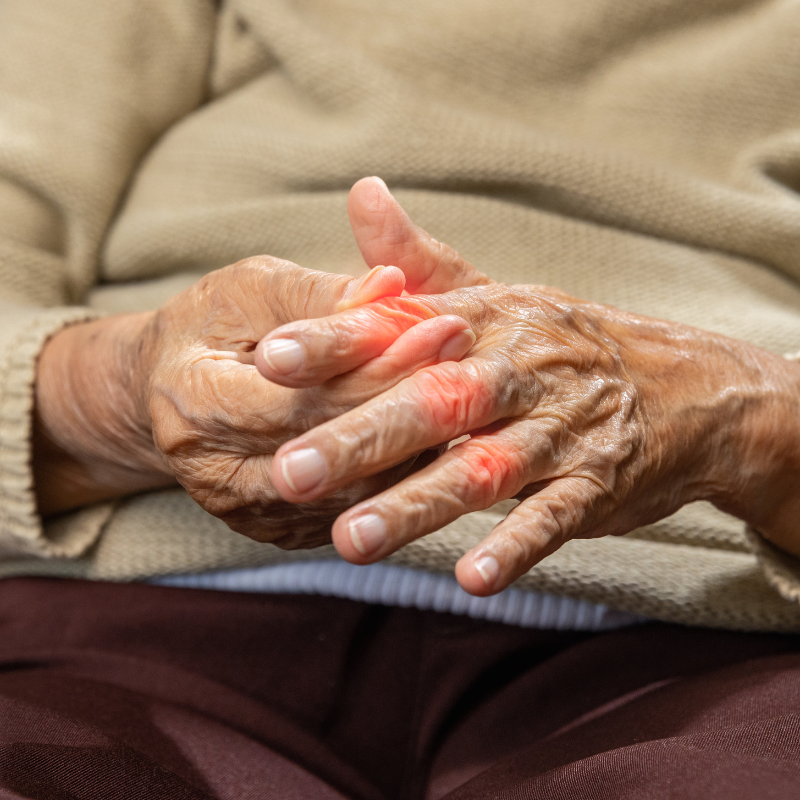Are you constantly battling with sore joints in your fingers?
Whether you're dealing with arthritis, repetitive motion injuries, or just general wear and tear, finding relief can be a challenge. But fear not, because we're here to help you unlock the secrets to soothing those achy joints. In this article, we will share 5 effective ways to relieve the discomfort and improve the flexibility of your fingers.
From simple exercises and stretches to topical remedies and lifestyle changes, we've got you covered with practical solutions that you can easily incorporate into your daily routine. Discover the power of heat and cold therapy, explore the benefits of natural supplements, and learn the proper techniques to improve your finger mobility.
Say goodbye to the frustration and discomfort that sore joints bring and embrace a pain-free life. Join us as we dive into the world of finger joint relief and help you regain control of your everyday tasks. Let's unlock the potential for pain-free movement and find the relief you deserve.
Understanding sore joints in your fingers
Our fingers are incredibly important for our daily lives, enabling us to perform a wide range of tasks with dexterity and precision. From typing and writing to gripping and manipulating objects, our fingers are constantly in use. However, this frequent usage can take a toll on the joints, leading to a common condition known as sore joints in the fingers.
Sore joints, or joint pain, in the fingers can manifest in various ways, including stiffness, swelling, tenderness, and even limited range of motion. This discomfort can significantly impact our ability to carry out everyday activities, making even the simplest tasks a challenge. Understanding the underlying causes and the factors that contribute to sore finger joints is the first step in finding effective relief.
Whether you're dealing with the effects of aging, an underlying medical condition, or the consequences of repetitive strain, addressing the root cause of your finger joint pain is crucial. By delving into the various factors that can lead to sore joints, we can develop a comprehensive approach to managing and alleviating this common issue. Armed with this knowledge, you'll be better equipped to take control of your finger joint health and reclaim your quality of life.
Causes and risk factors for sore joints in your fingers
One of the primary causes of sore joints in the fingers is osteoarthritis, a degenerative joint condition that affects the cartilage and underlying bone. As we age, the cartilage that cushions the joints can wear down, leading to friction, inflammation, and pain. This type of arthritis is particularly common in the finger joints, especially the joints closest to the fingertips, known as the distal interphalangeal (DIP) joints.
Another common culprit behind sore finger joints is rheumatoid arthritis, an autoimmune disorder that causes the body's immune system to attack the joints. This chronic inflammatory condition can lead to swelling, stiffness, and ultimately, joint damage. The finger joints are often one of the first areas affected by rheumatoid arthritis, making them a common site of discomfort and impaired mobility.
In addition to these arthritic conditions, repetitive strain injuries (RSIs) can also contribute to sore finger joints. Repetitive motions, such as typing, writing, or playing musical instruments, can put excessive stress on the joints, leading to inflammation and pain. Individuals who engage in these activities for prolonged periods without proper breaks or ergonomic support are at a higher risk of developing sore finger joints.
The importance of early detection and treatment
Addressing sore joints in your fingers as soon as possible is crucial for managing the condition and preventing further deterioration. Early detection and prompt treatment can help alleviate the discomfort, improve joint function, and potentially slow the progression of the underlying condition.
When left untreated, sore finger joints can worsen over time, leading to increased pain, reduced mobility, and a diminished quality of life. Early intervention allows for the implementation of various treatment strategies, from lifestyle modifications and physical therapy to medical interventions, depending on the underlying cause and severity of the condition.
By seeking professional medical attention at the first signs of finger joint discomfort, you can work with your healthcare provider to develop a personalized treatment plan that addresses the root cause of your problem. This proactive approach can help you regain control over your finger joint health, minimize the impact on your daily activities, and prevent the condition from escalating into a more debilitating state.
Lifestyle changes to alleviate sore joints in your fingers
Making certain lifestyle adjustments can play a significant role in alleviating sore joints in your fingers. One of the most effective strategies is to maintain a healthy weight. Excess body weight can put additional stress on the joints, including those in the fingers, exacerbating pain and inflammation. By adopting a balanced diet and engaging in regular physical activity, you can help reduce the burden on your finger joints and alleviate the discomfort.
Incorporating ergonomic practices into your daily routine is another crucial lifestyle change. If your work or hobbies involve repetitive hand movements, such as typing, writing, or playing musical instruments, it's essential to ensure that your workstation or equipment is properly set up to minimize strain on your fingers. This may include using ergonomic keyboards, mice, or tools, taking regular breaks, and practicing proper posture and hand positioning.
Stress management is also an important consideration when addressing sore finger joints. Chronic stress can contribute to muscle tension, inflammation, and overall joint discomfort. Engaging in stress-reducing activities, such as meditation, yoga, or deep breathing exercises, can help alleviate the physical and psychological impact of stress on your finger joints.
Exercise and physical therapy for finger joint pain
Incorporating targeted exercises and physical therapy into your routine can be highly effective in managing sore joints in your fingers. Regular exercise can help improve joint flexibility, strength, and range of motion, ultimately reducing pain and discomfort.
One of the most beneficial exercises for finger joint pain is range-of-motion exercises. These gentle movements, such as bending, flexing, and extending the fingers, can help maintain and even improve the mobility of the joints. It's essential to perform these exercises with care, gradually increasing the intensity and duration to avoid further strain or injury.
Strengthening exercises, such as finger stretches and resistance band exercises, can also be beneficial in supporting the joints and reducing the risk of future discomfort. By strengthening the muscles and tendons surrounding the finger joints, you can enhance the overall stability and support of the affected areas.
In addition to at-home exercises, seeking the guidance of a physical therapist can be invaluable in addressing sore finger joints. A physical therapist can assess your specific condition, develop a customized treatment plan, and provide hands-on techniques, such as joint mobilization and massage, to alleviate pain and improve joint function.
Natural remedies and alternative treatments for sore finger joints
Alongside conventional medical treatments, there are several natural remedies and alternative therapies that can offer relief for sore finger joints. These holistic approaches can be used in conjunction with other treatment methods or as standalone options, depending on the severity of your condition and personal preferences.
Hemp seed oil, often referred to as natural Joint Health Oil, is highly regarded for its rich nutritional content, particularly its balance of omega-3 and omega-6 fatty acids, which are crucial for joint health. Known for its anti-inflammatory benefits, this oil can help reduce joint pain and enhance flexibility. Consistent use of hemp seed oil or our hemp oil capsules as a joint supplement may aid in nourishing cartilage, easing stiffness, and boosting mobility, making it a favored option for those looking for a natural way to support their joints and overall wellbeing.
Another natural option is the use of essential oils, such as peppermint, eucalyptus, or wintergreen oil. These oils can be applied topically to the affected finger joints, providing a soothing, cooling sensation that can help alleviate discomfort. The analgesic and anti-inflammatory properties of these oils may also contribute to their effectiveness in managing sore finger joints.
Complementary therapies, such as acupuncture and massage, have also been explored for their potential in addressing finger joint pain. Acupuncture, a traditional Chinese medicine practice, involves the strategic placement of thin needles into specific points on the body, which may help stimulate the body's natural healing processes and reduce inflammation. Massage, on the other hand, can help improve circulation, relax muscles, and alleviate the tension that can contribute to sore finger joints.
Medications and medical interventions for finger joint pain
In cases where lifestyle changes, natural remedies, and physical therapy are not enough to provide relief for sore finger joints, medical interventions may be necessary. Your healthcare provider can assess the severity of your condition and recommend appropriate medications or other treatments to help manage the pain and improve joint function.
One common medical approach for sore finger joints is the use of over-the-counter or prescription anti-inflammatory medications, such as nonsteroidal anti-inflammatory drugs (NSAIDs) or corticosteroids. These medications can help reduce inflammation and alleviate pain, providing temporary relief for the affected joints.
In more severe cases, your healthcare provider may recommend the use of topical pain relievers, such as creams or gels containing ingredients like menthol or capsaicin. These products can be applied directly to the affected finger joints, delivering targeted relief and potentially reducing the need for oral medications.
In some instances, more advanced medical interventions may be necessary to address sore finger joints. These can include joint injections, which involve the direct administration of corticosteroids or other medications into the affected joint, or even surgical procedures, such as joint replacement or fusion, in cases of severe, debilitating joint damage. Your healthcare provider will work with you to determine the most appropriate course of action based on the severity of your condition and your individual needs.
Tips for preventing and managing sore joints in your fingers
Proactive steps can go a long way in preventing and managing sore joints in your fingers. One of the most important tips is to maintain good posture and ergonomic practices, especially if your daily activities involve repetitive hand movements. Ensure that your workstation, tools, and equipment are designed to minimize strain on your fingers and promote proper hand positioning.
Incorporating regular breaks and stretching exercises into your routine can also help prevent the development of sore finger joints. Taking short breaks to move and flex your fingers can help improve circulation and reduce the risk of overuse injuries. Additionally, exploring the use of ergonomic tools, such as specialized keyboards or writing utensils, can help alleviate the strain on your fingers.
Maintaining a healthy lifestyle, including a balanced diet and regular exercise, can also contribute to the prevention and management of sore finger joints. By maintaining a healthy weight and keeping your muscles and joints strong, you can reduce the burden on your finger joints and improve their overall resilience.
In the event that you do experience sore finger joints, it's important to address the issue promptly. Seek medical attention if the discomfort persists or worsens, as early intervention can be crucial in managing the underlying condition and preventing further deterioration. Your healthcare provider can work with you to develop a comprehensive treatment plan tailored to your specific needs, incorporating a combination of lifestyle modifications, physical therapy, and, if necessary, medical interventions.
Support and resources for coping with finger joint pain
Living with sore finger joints can be a challenging and frustrating experience, but you don't have to face it alone. There are numerous support resources and communities available to help you navigate the journey of managing and coping with finger joint pain.
One valuable resource is connecting with support groups, either in-person or online, where you can share your experiences, learn from others, and find camaraderie. These groups can provide a safe and supportive environment to discuss your concerns, exchange tips and strategies, and receive emotional support from individuals who understand what you're going through.
Additionally, many organizations and advocacy groups, such as the Arthritis Foundation or the American College of Rheumatology, offer a wealth of educational resources, including informative websites, publications, and hotlines. These resources can help you better understand your condition, explore treatment options, and find ways to manage the impact of sore finger joints on your daily life.
For those seeking professional guidance, consulting with a physical therapist or occupational therapist can be incredibly beneficial. These healthcare providers can help you develop personalized exercise and activity modification plans, provide hands-on treatment techniques, and offer strategies for adapting your daily tasks to accommodate your finger joint needs.
Conclusion: Taking control of your finger joint health
Sore joints in your fingers can be a frustrating and debilitating condition, but with the right approach, you can regain control of your finger joint health and improve your quality of life. By understanding the underlying causes, recognizing the importance of early detection and treatment, and implementing a comprehensive plan that combines lifestyle changes, natural remedies, and medical interventions, you can effectively manage and alleviate the discomfort associated with sore finger joints.
Remember, your finger joint health is a crucial component of your overall well-being, and taking proactive steps to address any issues can have a profound impact on your daily activities, productivity, and overall quality of life. Embrace the strategies and resources outlined in this article, and embark on a journey towards a pain-free, flexible, and empowered future for your fingers.
By unlocking the secrets to soothing sore finger joints, you'll be able to reclaim your independence, enjoy your hobbies and passions without limitation, and maintain the dexterity and mobility that are essential for navigating the world around you. Embrace this opportunity to take control of your finger joint health and unlock the relief you deserve.



